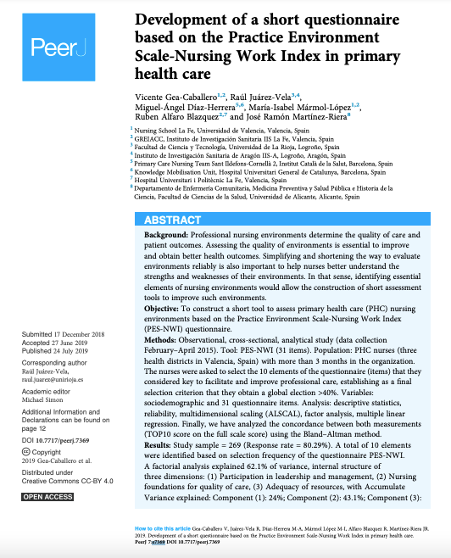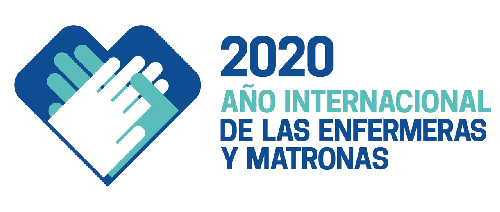Vicente Gea-Caballero, Raúl Júarez-Vela, Miguel Ángel Díaz-Herrera, María-Isabel Mármol-Lópezy José Ramón Martínez-Riera, coordinador y componentes del Grupo ENSAENF de AEC, junto a otro compañero, Ruben Alfaro Blazquez, publicaron este artículo original titulado “Development of a short questionnaire based on the Practice Environment Scale-Nursing Work Index in primary health care” [Desarrollo de un cuestionario breve basado en la Escala de Ambiente de Práctica-Índice de Trabajo de Enfermería en atención primaria de salud] en 2019, en la revista PeerJ, volumen 7, e7369.
Podéis leer el resumen del mismo a continuación y su texto completo en el documento adjunto:
Background:Professional nursing environments determine the quality of care and patient outcomes. Assessing the quality of environments is essential to improve and obtain better health outcomes. Simplifying and shortening the way to evaluate environments reliably is also important to help nurses better understand the strengths and weaknesses of their environments. In that sense, identifying essential elements of nursing environments would allow the construction of short assessment tools to improve such environments.
Objective:To construct a short tool to assess primary health care (PHC) nursing environments based on the Practice Environment Scale-Nursing Work Index (PES-NWI) questionnaire.
Methods:Observational, cross-sectional, analytical study (data collection February–April 2015). Tool: PES-NWI (31 items). Population: PHC nurses (three health districts in Valencia, Spain) with more than 3 months in the organization. The nurses were asked to select the 10 elements of the questionnaire (items) that they considered key to facilitate and improve professional care, establishing as a final selection criterion that they obtain a global election >40%. Variables: sociodemographic and 31 questionnaire items. Analysis: descriptive statistics, reliability, multidimensional scaling (ALSCAL), factor analysis, multiple linear regression. Finally, we have analyzed the concordance between both measurements (TOP10 score on the full scale score) using the Bland–Altman method.
Results:Study sample = 269 (Response rate = 80.29%). A total of 10 elements were identified based on selection frequency of the questionnaire PES-NWI. A factorial analysis explained 62.1% of variance, internal structure of three dimensions: (1) Participation in leadership and management, (2) Nursing foundations for quality of care, (3) Adequacy of resources, with Accumulate Variance explained: Component (1): 24%; Component (2): 43.1%; Component (3): 62.1%. Reliability (Cronbach’s Alpha) was 0.816 for short questionnaire, and >0.8 for all measurements. Stress = 0.184 and RSQ = 0.793. Bland–Altman method: the scaling tends to be 1.92 points higher (equivalent to a maximum deviation of 1.54%) than the full-scale PES-NWI score (max score on PES-NWI = 124 points).
Conclusions:It is possible to identify essential elements of environments to construct a short tool that simplifies the study of PHC environments. Conducting rapid studies of environments will provide managers with information about specific elements that require prioritization to enhance quality of care and safety.









